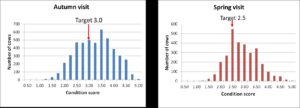Achievement Of Suckler Cow Condition Score Targets
18 October 2017Recommended condition score targets for spring calving suckler cows are for a score of 3 at housing and 2.5 at calving. These targets have been settled upon as the best compromise between calving ease, winter feed costs and adequate nutrient provision to achieve a healthy birth weight of calf and to allow the cow to return to oestrus. In recent years growing evidence suggests that nutritional restriction during pregnancy can affect the lifetime development of the offspring of many species even if they appear to be normal at birth. SRUC has been funded by the Scottish Government to examine the effects of cow body condition on the lifetime productivity and welfare of calves in suckler herds, in addition to the period around birth. The project is in its early days and later articles will report the effects of cow condition on the calf. Here we report how closely herds are meeting the existing guidelines for cow condition.
In the initial part of the study we have body condition scored 3256 pregnant cows on two occasions using the conventional scale from 0-5 during the autumn of 2016 and spring of 2017. The majority were winter housed but some were outwintered. At housing, we found that 14% were more than half a score below the target of 3.0 whilst 33% were more than half a score above (Figure 1). At calving, 4% were more than half a score below the target of 2.5 and 35% were more than half a score above (Figure 2).
This suggests that a third of cows come off pasture in 2016 over-fit and retained this over-fit condition through the 2016-17 winter. This represents a potential waste of winter feed and a likely increased risk of calving difficulties. It was encouraging to see that the percentage of overly lean cows fell during the winter period suggesting that in most cases interventions to improve condition of cows that were too lean at housing were successful. The percentages of lean cows were notably lower than that of overly fit cows, suggesting that management of over-condition was the greater challenge, although this may not be surprising since the grass growing season was prolonged by a mild autumn in 2016. The relative scarcity of overly-lean cows should not be a cause for complacency. Some of those that were more than half a condition score point below target, especially at calving, were probably under sufficient nutritional stress for this to affect the pre-natal and post-natal development of their calf and their ability to return to calf in the following year. The subsequent parts of our study in the coming years will confirm if these expectations are realised.
Simon Turner, simon.turner@sruc.ac.uk
Sign up to the FAS newsletter
Receive updates on news, events and publications from Scotland’s Farm Advisory Service

